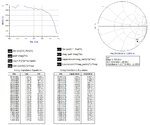Northern_Lights
Newbie level 5
Hi,
I have an s-parameter file from a measured passive structure from a VNA. I have used equations in ADS to generate Inductance and Capacitance from Impedance and Admittance of the measured s-parameters. The Capacitance is in the ball park with expected values. however the Inductance is not. Some questions:
1. Any experts on ADS that can take a look at the equations/formulas. Do they look correct?
2. if the equations are right why is there a difference in the two methods? Is it just due to conversion numerical error?
3. The Capacitance values are in the ball park with expected values from simulation but not the inductance. why could that be? I expected about 7 nH of Inductance from this structure.

TIA
I have an s-parameter file from a measured passive structure from a VNA. I have used equations in ADS to generate Inductance and Capacitance from Impedance and Admittance of the measured s-parameters. The Capacitance is in the ball park with expected values. however the Inductance is not. Some questions:
1. Any experts on ADS that can take a look at the equations/formulas. Do they look correct?
2. if the equations are right why is there a difference in the two methods? Is it just due to conversion numerical error?
3. The Capacitance values are in the ball park with expected values from simulation but not the inductance. why could that be? I expected about 7 nH of Inductance from this structure.

TIA